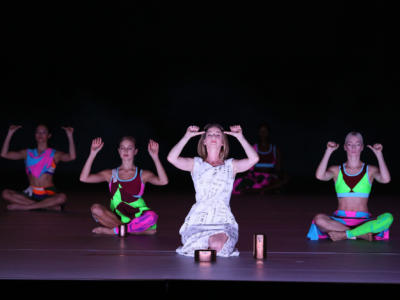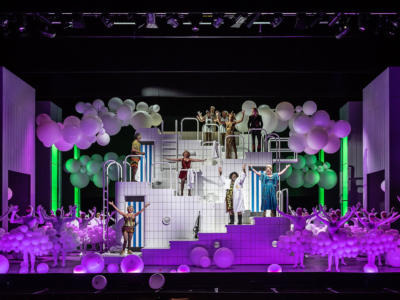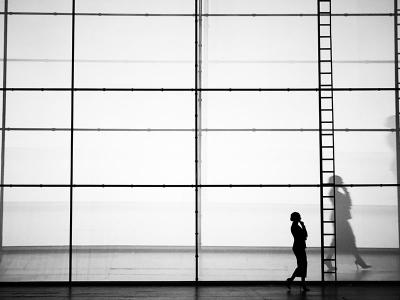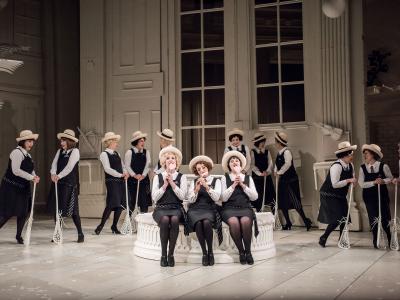ENO Response: Luisa Miller reviews
17th February 2020 in News
ENO Response is a new scheme that gives aspiring journalists and reviewers the opportunity to produce opera reviews and receive writing advice and feedback.
ENO has had no editorial input in the reviews. All views are their own.
Patrick Shorrock
Performances of Verdi’s Luisa Miller are about as rare as productions of Schiller’s Intrigue and Love, the play it’s based on. In this new ENO production, it is easy to see why it doesn’t get staged often, but also why it’s worth staging now and then.
Despite what the programme essay says, it sounds quite a lot like early Verdi – written after Macbeth but before Rigoletto – and is musically a bit uneven, with a tendency to eruptions of predictable rum ti tum alongside the more interesting stuff. There are some foretastes of what Verdi would produce later, including a nervily good overture, some fine duets, a stand out tenor aria, and a vocal quartet that is unusually unaccompanied. But, frankly, the justification for this revival is the wonderful opportunities the music provides for singing; opportunities which this outstanding cast, under the unobtrusively effective conducting of Alexander Joel, made the most of.
No-one able to sing Verdi’s demanding music is going to convince as a couple of death-obsessed teenagers, but, with a cast as fine as this, no-one in their operatic right mind is going to care. Elizabeth Llewelyn in the title role is a bit slow to warm up – but she has all the notes (including some tricky coloratura before Verdi gets into his groove) and is magnificent after the interval, making the most of Verdi’s soaring lines. David Junghoon Kim, as her lover, was a splendid Rodolpho – the real tenor deal – with a vocal technique that enables him to sing softly and ring out thrillingly, and the musicality, and dramatic instinct to know which to do when. He may not be the world’s greatest physical actor but was always involved and sincere: every note meant something. He has the potential to be Korea’s answer to Carlo Bergonzi.
They are supported by a vocally excellent cast, including Christine Rice’s Federica, who displays some rather thrillingly dark vocal colour, and a couple of splendid villains in the form of James Creswell’s baleful Count Walter and Solomon Howard’s Wurm, who is young and sexy in a nasty kind of way and a black vest that shows off his muscles, much more interesting than the physically repulsive and slightly comic character Verdi envisaged. Olafur Sigurdarson is an impressive Miller, although he sometimes sounds a long way north of Italy and there is perhaps more sonorousness to be found in the part.
Intrigue and Love is perhaps Schiller at his most predictable but still interesting, with a manipulative and morally compromised father and his villainous sidekick using every dirty trick in the book, including extortion and blackmail, in their determination to marry off the son to Duchess Federica when he is love with nice middle-class girl Luisa. A drama with a villain called Wurm is clearly not aspiring to subtlety. The conflict is a bit simplistic and one-sided but is far from irrelevant in these days of extinction rebellion vs the polluting boomers.
Director Barbara Horakova’s production has many of the clichés and irritations of the earnestly German style of modern opera productions including a chorus in white make-up and underwear, white walls that gradually get covered in graffiti and dripping black paint, sinister dancers in black intruding where they are not wanted, and child extras playing Rodolpho and Luisa as children. But its intense seriousness is absolutely right for the piece and avoids generating giggles, despite the clunkiness of the scenario and translation. Every now and then, it actually decides to be straightforwardly effective or even visually pleasing. Although it is edgy enough to attract a few boos, it is never less than adequate, even if not entirely satisfactory. People forget all too easily how awful traditional Verdi warhorse productions can be.
This piece is more about foreshadowing future greatness and shows that both Schiller and Verdi had some artistic maturing to do – which they did to stunning effect in Don Carlos, which also shows a father and son at odds. In this piece, we have a tenor who starts as Alfredo, then morphs into Adorno, stricken by incredulous jealousy, and finally Otello, killing his beloved as a result of the manipulations of Wurm, with the lovers dying in one another’s arms as if it were Aida. We also have a father-daughter duet that reminds you what Verdi would achieve afterwards within Rigoletto and Simon Boccanegra.
I can’t honestly say that I’m gagging for a revival of I Masnadieri – written before Luisa Miller and Verdi’s take on Schiller’s The Robbers, which was written before Intrigue and Love – but it’s about time London had the chance to realise that Mary Stuart and Don Carlos aren’t the only Schillers worth putting on the stage. How about his Wallenstein trilogy?
Daniel Shailer
If Horakova’s production isn’t subtle that’s because Luisa Millar isn’t a particularly subtle story. Luisa is impossibly good; Wurm is impossibly bad. The lights go up on an impossibly white set that is (inevitably) daubed, smeared and oozed with darkness until the inevitably fatal conclusion. It’s a little predictable, yes, but it’s dark and twisted and very effective.
It feels like we’re inside Luisa’s head, fighting off nightmares and marionette monsters – horror-show clowns beckoning from the dark. There is an element of dream and subconscious to Andrew Lieberman’s towering white walls, like a therapist’s stark waiting room. The stock, crayoned drawings of stick-houses and happy families under a smiling sun are destroyed by Wurm’s ghoulish troupe. It’s a compelling image of damaged childhood innocence, as are the young Luisa and Rodolfo. These childhood personas reappear at crucial moments; they are not so much memories or flashbacks, but embodiments of the innocence still alive in Rodolfo and Luisa, fighting against a corrupted world.
The stage is allowed to become chaotic: childhood teddy bears and scraps litter the floor so that by the end, neither good nor evil can really be said to have won, it’s just a dark, blood-soaked mess. This is the inevitability Horakova wants to highlight in Luisa Miller. We’re watching a fall, not only from innocence and youth but order and control – the benevolent providence of a god or parent. The frame of a giant house predominates the first half visually, but also as a thematic gesture towards the family bonds that define the characters’ relationships to class, to parents and to each other. A change of perspective in the second half and this family paradise is Luisa’s prison cell. It’s an image that is characteristic of this production: big, broad-brush symbolism that is not particularly nuanced but is eloquent, clear and hard-hitting.
In a fitting testament to this Romeo & Juliet struggle between individual and society, individual performances shine through quite a stylised, strict interpretation. James Creswell brings us Count Walter as sauntering mafia boss and his bass duet with Soloman Howard’s Wurm is powerfully rich and sonorous. This is just one example of small group singing that really sets the mark for an evening of outstanding vocal quality.
The leading voices stand out of a technically compelling overall musical performance. Recitative and aria are joined unpretentiously in a way that makes the performance flow well. Elizabeth Llewellyn’s coloratura moments are less about vocal fireworks and more about emotional interaction; her voice shifts for moments of characterisation, but what is lost in vocal precision is amply made up in the life Llewellyn gives the role. All of this means that Verdi’s music is less alienating than it might have been to new audiences. On top of this, Mark Biggins’ chorus supplies some of the most powerful and versatile singing at the Coliseum this season.
A few superfluous moments aside (an impromptu wrestling wring that Rodolfo has to escape seems hard to justify) this production is sharp, theatrical and delivers a desperate emotional punch. Make up your own mind about Horakova’s sparse, monochrome interpretation; the vocal performances are undeniable and justify themselves.
Aine Kennedy
This season’s Luisa Miller is as sonically alluring as it is visually haggard. Barbara Horáková’s production puts an edgy psychological spin on Verdi’s tale of 17th-century Tyrolean intrigue, replacing lederhosen with mesh vests and villagers with suspender-clad clowns. Despite a wide array of surprising design influences, the musical performances were consistently focused and convincing, with both the orchestra and the ensemble cast continuing to astonish across nearly three hours.
After the historical melodrama of his two previous operas, Attila and Macbeth, Verdi turned to a more intimate realm for Luisa Miller. This development is reflected in his use of a small cast of well-rounded central characters, whose domestic strife has far-reaching consequences. ENO’s production is well served in this regard by an exceptional lineup of singers, delivering individually memorable performances- quite a feat in an opera of this length.
There are only six central characters, all but one of whom are related by blood. It is the combination of their intimacy and their individuality which drives the plot, and ultimately leads to disaster; both traits were brilliantly conveyed by singers who, like their characters, were all somehow exceptional.
It is rare in an opera for every new character to make you sit up in your seat. The singers are good, of course, but in a production with a larger cast, they cannot all be amazing. Every central character in Luisa Miller had real virtuosic charisma which was only increased by the contrast they posed with each other. In the title role, Elizabeth Llewellyn portrayed Luisa’s growth from young ingenue to mature tragic heroine with impeccable technique and a real poignancy; her upper register, instantly recognisable even heard in conjunction with a full chorus, was equally effective denouncing the evil of Wurm or professing her love for her father. Llewellyn received the most enthusiastic reception at the curtain call, together with David Junghoon Kim’s Rodolfo. Kim drew several ovations over the course of the opera for his bel canto arias, particularly the notoriously challenging ‘Quando le sere al placido’ at the end of Act II.
It was a pleasure to see a cast so international, as well as so talented: Kim, a Korean tenor, appeared alongside the British Luisa, an American Wurm, and an Icelandic Miller. The dynamic between the two fathers of the doomed couple- James Cresswell as Count Walter and Olafur Sigurdason as Miller- was particularly effective. Their two contrasting notions of fatherhood and masculinity were played out in respective bass and baritone registers, emphasising the commonalities which ultimately drove them apart; as the opera progressed, it became clear that both had been driven at some point by parental love and a desire to provide for their child. Soloman Howard’s Wurm was musically convincing, even if his catwalk-ready appearance seemed incongruous with the role of repulsive, sleazy villain. The orchestra, under the baton of Alexander Joel, made magnificent work of Verdi’s score. Luisa Miller is generally lively and pastoral in tone, taking its tone from the sprightly yet rustic overture, which sweeps the audience up in a vigorous, cymbal-laced flurry with a charming clarinet solo. The overture performed this week was the most convincing I have yet heard at ENO. The orchestra was self-assured and well-coordinated; synchronisation both amongst themselves and with the performers on stage was maintained through most of the show. Verdi’s music can feel slightly repetitive at times, partly owing to the sheer bulk of it, but despite the proliferation of certain elements- tender duets, angry rebukes, mournful self-reflection- the musicians kept it constantly enlivened.
If the musical performances had ever been in danger of losing the audience’s interest, the stage design ensured alternative entertainment. Andrew Lieberman’s set is initially composed of towering, blank walls, which move around to depict different settings and to enclose the characters. These structures are progressively covered in graffiti and various other substances: like many of the costumes, and indeed the performers, undergo a fairly blunt transformation from spotless purity to oily sordidness. An outrageously costumed chorus and dance troupe were on hand to remind the audience of the edgy, psychological tone of the production at any moment where Verdi’s music strayed too long into the familiar. Thus, Count Walter’s ‘I mio sangue la vita darei’ aria- a reflection on the trials of fatherhood- was enlivened by a trembling, mostly-nude dancer dragged on stage in a bin bag, bringing a whole new meaning to ‘men are trash’. The dancer in question, who Count Walter managed to dextrously smear with paint and drag around by the hair as he sang, seemed to be a representation of Rodolfo’s younger self. Such avatars were everywhere in the performance, notably with two child actors representing the protagonists’ younger days of romance. Horáková’s aesthetic swung from sultry Elizabethan clowns to a Dia de Los Muertos-inflected hunt scene; the uncanny and disconcerting effect of the juxtaposition was enhanced by the melted-face masks of the dancers.
ENO’s production is a bricolage of the familiar and the unknown, highlighting the timeless forces of human nature which lead to such rapid and tragic reversal of fortune. The strength of these forces- love, jealousy, greed, and anger- is well matched by the strength of the production’s cast.






